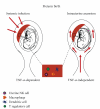TLR-mediated preterm birth in response to pathogenic agents
- PMID: 20827416
- PMCID: PMC2933901
- DOI: 10.1155/2010/378472
TLR-mediated preterm birth in response to pathogenic agents
Abstract
The incidence of preterm birth in developed countries has risen in the past decades. Underlying causes for this enigmatic pregnancy complication are numerous, yet infectious agents that induce dysregulation of immunity at the maternal-fetal interface pose one of the most probable causes of preterm birth. This paper highlights two factors regarding maternal infections that trigger unscheduled inflammatory sequences that are deleterious to the maternal-fetal balance necessary to maintain pregnancy. Firstly, we discuss the role of Toll-like receptors (TLRs) as sentinels of uterine immunity in the context of response to pathogens. We highlight the idea that particular TLR activations lead to differential immune cascades that induce preterm birth. Secondly, two alternative routes of pathogenic entry may prove to be critical for inducing preterm birth via a cytokine storm or a secondary and currently unknown cell-mediated mechanism of uterine inflammation. This paper summarizes pathways that underlie activation of adverse and diverse immune responses to foreign agents that may result in preterm birth.
Figures

Similar articles
-
Toll-like receptors at the maternal-fetal interface in normal pregnancy and pregnancy complications.Am J Reprod Immunol. 2014 Aug;72(2):192-205. doi: 10.1111/aji.12258. Epub 2014 Apr 23. Am J Reprod Immunol. 2014. PMID: 24754320 Review.
-
Intrauterine infection and preterm labor.Semin Fetal Neonatal Med. 2012 Feb;17(1):12-9. doi: 10.1016/j.siny.2011.09.001. Epub 2011 Sep 25. Semin Fetal Neonatal Med. 2012. PMID: 21944863 Free PMC article. Review.
-
Inflammatory mechanisms of preterm labor and emerging anti-inflammatory interventions.Cytokine Growth Factor Rev. 2024 Aug;78:50-63. doi: 10.1016/j.cytogfr.2024.07.007. Epub 2024 Jul 20. Cytokine Growth Factor Rev. 2024. PMID: 39048393 Review.
-
Evidence for activation of Toll-like receptor and receptor for advanced glycation end products in preterm birth.Mediators Inflamm. 2010;2010:490406. doi: 10.1155/2010/490406. Epub 2010 Nov 28. Mediators Inflamm. 2010. PMID: 21127710 Free PMC article. Review.
-
Plasma inflammatory and immune proteins as predictors of intra-amniotic infection and spontaneous preterm delivery in women with preterm labor: a retrospective study.BMC Pregnancy Childbirth. 2018 May 9;18(1):146. doi: 10.1186/s12884-018-1780-7. BMC Pregnancy Childbirth. 2018. PMID: 29743041 Free PMC article.
Cited by
-
Trophoblasts Modulate the Ca2+ Oscillation and Contraction of Myometrial Smooth Muscle Cells by Small Extracellular Vesicle- (sEV-) Mediated Exporting of miR-25-3p during Premature Labor.Oxid Med Cell Longev. 2021 Aug 7;2021:8140667. doi: 10.1155/2021/8140667. eCollection 2021. Oxid Med Cell Longev. 2021. PMID: 34413928 Free PMC article.
-
Fetal skin as a pro-inflammatory organ: Evidence from a primate model of chorioamnionitis.PLoS One. 2017 Sep 28;12(9):e0184938. doi: 10.1371/journal.pone.0184938. eCollection 2017. PLoS One. 2017. PMID: 28957335 Free PMC article.
-
Cnr2 deficiency confers resistance to inflammation-induced preterm birth in mice.Endocrinology. 2014 Oct;155(10):4006-14. doi: 10.1210/en.2014-1387. Epub 2014 Jul 22. Endocrinology. 2014. PMID: 25051450 Free PMC article.
-
Estradiol alters the immune-responsiveness of cervical epithelial cells stimulated with ligands of Toll-like receptors 2 and 4.PLoS One. 2017 Mar 15;12(3):e0173646. doi: 10.1371/journal.pone.0173646. eCollection 2017. PLoS One. 2017. PMID: 28296959 Free PMC article.
-
Fetal and Neonatal Effects of N-Acetylcysteine When Used for Neuroprotection in Maternal Chorioamnionitis.J Pediatr. 2016 Jan;168:67-76.e6. doi: 10.1016/j.jpeds.2015.09.076. Epub 2015 Nov 3. J Pediatr. 2016. PMID: 26545726 Free PMC article. Clinical Trial.
References
-
- van Mourik MSM, Macklon NS, Heijnen CJ. Embryonic implantation: cytokines, adhesion molecules, and immune cells in establishing an implantation environment. Journal of Leukocyte Biology. 2009;85(1):4–19. - PubMed
-
- Kelly RW, King AE, Crithley HOD. Cytokine control in human endometrium. Reproduction. 2001;121(1):3–19. - PubMed
-
- Challis JR, Lockwood CJ, Myatt L, Norman JE, Strauss JF, III, Petraglia F. Inflammation and pregnancy. Reproductive Sciences. 2009;16(2):206–215. - PubMed
Publication types
MeSH terms
Substances
LinkOut - more resources
Full Text Sources
Medical
Miscellaneous

